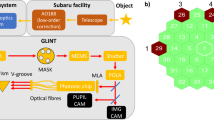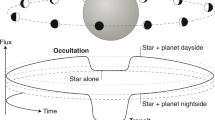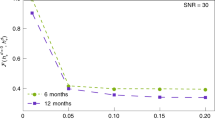Abstract
High angular resolution observations at optical wavelengths provide valuable insights into stellar astrophysics1,2, and enable direct measurements of fundamental stellar parameters3,4 and the probing of stellar atmospheres, circumstellar disks5, the elongation of rapidly rotating stars6 and the pulsations of Cepheid variable stars7. The angular size of most stars is of the order of one milliarcsecond or less, and to spatially resolve stellar disks and features at this scale requires an optical interferometer using an array of telescopes with baselines on the order of hundreds of metres. We report on the implementation of a stellar intensity interferometry system developed for the four VERITAS imaging atmospheric Cherenkov telescopes. The system was used to measure the angular diameter of the two sub-milliarcsecond stars β Canis Majoris and ϵ Orionis with a precision of greater than 5%. The system uses an offline approach in which starlight intensity fluctuations that are recorded at each telescope are correlated post observation. The technique can be readily scaled onto tens to hundreds of telescopes, providing a capability that has proven technically challenging to the current generation of optical amplitude interferometry observatories. This work demonstrates the feasibility of performing astrophysical measurements using imaging atmospheric Cherenkov telescope arrays as intensity interferometers and shows the promise for integrating an intensity interferometry system within future observatories such as the Cherenkov Telescope Array.
This is a preview of subscription content, access via your institution
Access options
Access Nature and 54 other Nature Portfolio journals
Get Nature+, our best-value online-access subscription
$29.99 / 30 days
cancel any time
Subscribe to this journal
Receive 12 digital issues and online access to articles
$119.00 per year
only $9.92 per issue
Buy this article
- Purchase on Springer Link
- Instant access to full article PDF
Prices may be subject to local taxes which are calculated during checkout


Similar content being viewed by others
Data availability
The data that support the plots within this paper and other findings of this study are available from the corresponding authors upon reasonable request. Given the extremely large datasets obtained during the observations, in excess of 40 TB, only the post-correlation data can be reasonably made available.
Code availability
The software used to analyse the data in this study is available upon request to the corresponding authors.
References
Monnier, J. Optical interferometry in astronomy. Rep. Prog. Phys. 66, 789–857 (2003).
Ridgway, S. et al. Revitalizing the optical/infrared interferometry community in the U.S. Bull. Am. Astron. Soc. 51, 157 (2019).
Boyajian, T. S. et al. Stellar diameters and temperatures. III. Main-sequence A, F, G, and K stars: additional high-precision measurements and empirical relations. Astrophys. J. 771, 40 (2013).
Casagrande, L. et al. Towards stellar effective temperatures and diameters at 1 per cent accuracy for future surveys. Mon. Not. R. Astron. Soc. 439, 2060–2073 (2014).
Kraus, S. et al. Gas distribution, kinematics, and excitation structure in the disks around the classical Be stars β Canis Minoris and ζ Tauri. Astrophys. J. 744, 19 (2012).
van Belle, G. T. Interferometric observations of rapidly rotating stars. Astron. Astrophys. Rev. 20, 51 (2012).
Kervella, P. et al. Observational calibration of the projection factor of Cepheids: III. The long-period Galactic Cepheid RS Puppis. Astron. Astrophys. 600, A127 (2017).
Labeyrie, A., Lipson, S. G. & Nisenson, P. An Introduction to Optical Stellar Interferometry (Cambridge Univ. Press, 2006).
Hanbury Brown, R. & Twiss, R. Q. Interferometry of the intensity fluctuations in light. Part I. Basic theory: the correlation between photons in coherent beams of radiation. Proc. R. Soc. Ser. A 242, 300–324 (1957).
Hanbury Brown, R. The Intensity Interferometer; its applications to astronomy (Taylor & Francis, 1974).
Hanbury Brown, R., Davis, J. & Allen, L. R. The angular diameters of 32 stars. Mon. Not. R. Astron. Soc. 167, 121–136 (1974).
LeBohec, S. & Holder, J. Optical intensity interferometry with atmospheric Cerenkov telescope arrays. Astrophys. J. 649, 399–405 (2006).
Pilyavsky, G. et al. Single-photon intensity interferometry (SPIIFy): utilizing available telescopes. Mon. Not. R. Astron. Soc. 467, 3048–3055 (2017).
Lacki, B. C. Cherenkov telescopes as optical telescopes for bright sources: today’s specialized 30-m telescopes? Mon. Not. R. Astron. Soc. 416, 3075–3082 (2011).
Rou, J., Nuñez, P. D., Kieda, D. & LeBohec, S. Monte Carlo simulation of stellar intensity interferometry. Mon. Not. R. Astron. Soc. 430, 3187–3195 (2013).
Dravins, D., Lagadec, T. & Nuñez, P. Optical aperture synthesis with electronically connected telescopes. Nat. Commun. 6, 6852 (2015).
Weiss, S. A., Rupert, J. D. & Horch, E. P. Stellar photon correlation detection with the Southern Connecticut stellar interferometer. In Optical and Infrared Interferometry and Imaging VI, Proc. SPIE Vol. 10701 (eds Creech-Eakman, M. J., et al.), 107010X (2018).
Zampieri, L. et al. Intensity interferometry with Aqueye+ and Iqueye in Asiago. In Optical and Infrared Interferometry and Imaging V, Proc. SPIE Vol. 9907 (eds Malbet, F. et al.), 99070N (2016).
Tan, P. K., Chan, A. H. & Kurtsiefer, C. Optical intensity interferometry through atmospheric turbulence. Mon. Not. R. Astron. Soc. 457, 4291–4295 (2016).
Zmija, A. et al. LED as laboratory test source for astronomical intensity interferometry. Opt. Express 28, 5248–5256 (2020).
Guerin, W. et al. Spatial intensity interferometry on three bright stars. Mon. Not. R. Astron. Soc. 480, 245–250 (2018).
Acciari, V. A. et al. Optical intensity interferometry observations using the MAGIC imaging atmospheric Cherenkov telescopes. Mon. Not. R. Astron. Soc. 491, 1540–1547 (2019).
Rivet, J. P. et al. Intensity interferometry of P Cygni in the Hα emission line: towards distance calibration of LBV supergiant stars. Mon. Not. R. Astron. Soc. 494, 218–227 (2020).
Kieda D., LeBohec, C. & Cardon, R. Augmentation of VERITAS telescopes for stellar intensity interferometry. In 36th International Cosmic Ray Conference, 714 (Proceedings of Science, 2019).
Ségransan, D. Observability and UV coverage. New Astron. Rev. 51, 597–603 (2007).
Acharyya, A. et al. Monte Carlo studies for the optimisation of the Cherenkov telescope array layout. Astropart. Phys. 111, 35–53 (2019).
Nuñez, P. D., Holmes, R., Kieda, D., Rou, J. & LeBohec, S. Imaging submilliarcsecond stellar features with intensity interferometry using air Cherenkov telescope arrays. Mon. Not. R. Astron. Soc. 424, 1006–1011 (2012).
Dravins, D., LeBohec, S., Jensen, H. & Nuñez, P. D. Optical intensity interferometry with the Cherenkov telescope array. Astropart. Phys. 43, 331–347 (2013).
Nuñez, P. D. & Domiciano de Souza, A. Capabilities of future intensity interferometers for observing fast-rotating stars: imaging with two- and three-telescope correlations. Mon. Not. R. Astron. Soc. 453, 1999–2005 (2015).
Stee et. al. Science cases for a visible interferometer. Preprint at https://arxiv.org/abs/1703.02395 (2017).
Matthews, N., Kieda, D. & LeBohec, S. Development of a digital astronomical intensity interferometer: laboratory results with thermal light. J. Mod. Opt. 65, 1336–1344 (2018).
Matthews, N., Clarke, O., Snow, S., LeBohec S. & Kieda D. Implementation of an intensity interferometry system on the StarBase observatory. In Optical and Infrared Interferometry and Imaging VI, Proc. SPIE Vol. 10701 (eds Creech-Eakman, M. J., et al.), 107010W (2018).
Matthews, N. et. al. Astrophysical measurements with the VERITAS Stellar Intensity Interferometer. In 36th International Cosmic Ray Conference, 740 (Proceedings of Science, 2019).
Otte, A. N. et. al. The upgrade of VERITAS with high efficiency photomultipliers. In 32nd International Cosmic Ray Conference, 247 (2011).
Cardon, R., Matthews, N., Abeysekara, A. U. & Kieda, D. A fiber optic based high voltage system for stellar intensity interferometry observations. In 36th International Cosmic Ray Conference, 643 (Proceedings of Science, 2019).
Foellmi, C. Intensity interferometry and the second-order correlation function g(2) in astrophysics. Astron. Astrophys. 507, 1719–1727 (2009).
Born, M. & Wolf, E. in Principles of Optics Ch. 10 (Pergamon, 1980).
Hanbury Brown, R., Davis, J., Lake, R. J. W. & Thompson, R. J. The effects of limb darkening on measurements of angular size with an intensity interferometer. Mon. Not. R. Astron. Soc. 167, 474–484 (1974).
Holder, J. et al. The first VERITAS telescope. Astropart. Phys. 25, 391–401 (2006).
Claret, A. & Bloemen, S. Gravity and limb-darkening coefficients for the Kepler, CoRoT, Spitzer, uvby, UBVRIJHK, and Sloan photometric systems. Astron. Astrophys. 529, A75 (2011).
Levenhagen, R. S. & Leister, N. V. Spectroscopic analysis of southern B and Be stars. Mon. Not. R. Astron. Soc. 371, 252–262 (2006).
Crowther, P. A., Lennon, D. J. & Walborn, N. R. Physical parameters and wind properties of Galactic early B supergiants. Astron. Astrophys. 446, 279–293 (2006).
Abt, H. A., Levato, H. & Grosso, M. Rotational velocities of B stars. Astrophys. J. 573, 359–365 (2002).
Acknowledgements
This research is supported by grants from the US Department of Energy Office of Science, the US National Science Foundation and the Smithsonian Institution, by NSERC in Canada and by the Helmholtz Association in Germany. We acknowledge the excellent work of the technical support staff at the Fred Lawrence Whipple Observatory and at the collaborating institutions for their maintenance of VERITAS and assistance with integrating the SII system. The authors gratefully acknowledge support from the US National Science Foundation grant nos. AST 1806262 and PHY 0960242, and from the University of Utah for the fabrication and commissioning of the VERITAS-SII instrumentation. This work is dedicated to the memory of Paul Nuñez.
Author information
Authors and Affiliations
Contributions
All authors contributed to the operation of the VERITAS telescopes and the internal review of the manuscript. N.M. and D.K. developed the SII hardware used in these observations with assistance from M.K.D. and G.H. in the integration with VERITAS; N.M. and D.K. wrote the data acquisition software; N.M. developed the FPGA correlator software; N.M. proposed the observations; N.M. and T.H. reduced and analysed the data; N.M., D.K., T.L., T.T.Y.L., D.R., Q.F., J.D., A.U.A. and A.F. took the observations; N.M. wrote the paper with guidance from T.L., M.K.D., D.K., T.H., M.P. and J.L.R.; and T.L. and D.K. provided key insights throughout this work.
Corresponding authors
Ethics declarations
Competing interests
The authors declare no competing interests.
Additional information
Peer review information Nature Astronomy thanks William Guerin and the other, anonymous, reviewer(s) for their contribution to the peer review of this work.
Publisher’s note Springer Nature remains neutral with regard to jurisdictional claims in published maps and institutional affiliations.
Extended data
Extended Data Fig. 1 Coverage of the sources in the (u, v)-plane.
Each of the coloured points represents different runs for a given telescope pair.
Rights and permissions
About this article
Cite this article
Abeysekara, A.U., Benbow, W., Brill, A. et al. Demonstration of stellar intensity interferometry with the four VERITAS telescopes. Nat Astron 4, 1164–1169 (2020). https://doi.org/10.1038/s41550-020-1143-y
Received:
Accepted:
Published:
Issue Date:
DOI: https://doi.org/10.1038/s41550-020-1143-y



